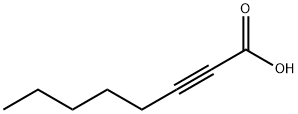2-OCTYNOIC ACID

|
- ₹0
- Product name: 2-OCTYNOIC ACID
- CAS: 5663-96-7
- MF: C8H12O2
- MW: 140.18
- EINECS:227-121-3
- MDL Number:MFCD00004364
- Synonyms:2-OCTYNOIC ACID;OCT-2-YNOIC ACID;RARECHEM AL BE 0742;2-Octynoicacid,98%;2-OCTANOIC ACID;META-PENTYLPROPIOLATE;2-OCTYNOIC ACID 96%;2-Octynoic acid, 98% 10GR
| Manufacturer | Product number | Product description | Packaging | Price | Updated | Buy |
|---|
Properties
Melting point :2-5 °C(lit.)
Boiling point :148-149 °C19 mm Hg(lit.)
Density :0.961 g/mL at 25 °C(lit.)
refractive index :n20/D 1.46(lit.)
Flash point :214 °F
storage temp. :Sealed in dry,Room Temperature
pka :2.45±0.10(Predicted)
form :liquid
color :Yellow
CAS DataBase Reference :5663-96-7(CAS DataBase Reference)
Boiling point :148-149 °C19 mm Hg(lit.)
Density :0.961 g/mL at 25 °C(lit.)
refractive index :n
Flash point :214 °F
storage temp. :Sealed in dry,Room Temperature
pka :2.45±0.10(Predicted)
form :liquid
color :Yellow
CAS DataBase Reference :5663-96-7(CAS DataBase Reference)
Safety Information
| Symbol(GHS): |

|
|||||||||||||||||||||
|---|---|---|---|---|---|---|---|---|---|---|---|---|---|---|---|---|---|---|---|---|---|---|
| Signal word: | Danger | |||||||||||||||||||||
| Hazard statements: |
|
|||||||||||||||||||||
| Precautionary statements: |
|
Description
ChEBI: Octanoic acid (caprylic acid) which has been doubly dehydrogenated at positions 2 and 3 to give the corresponding alkynoic acid. It is widely used in perfumes, lipstick, and many common food flavourings.More related product prices
2-OCTYNOIC ACID METHYL 2-OCTYNOATE ETHYL 2-NONYNOATE METHYL 2-NONYNOATE ETHYL 2-OCTYNOATE 2-OCTYNERelated product price
- METHYL 2-OCTYNOATE
₹1594-192706.65 - METHYL 2-NONYNOATE
₹2012-50238.83 - 2-OCTYNE
₹2800-7600






